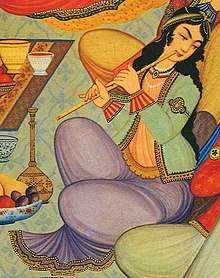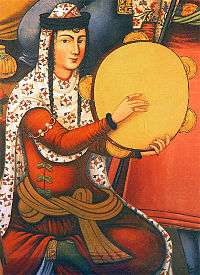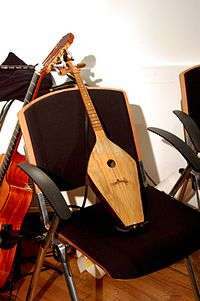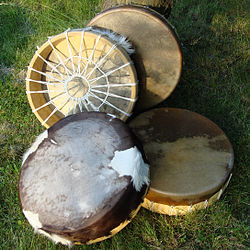Dayereh
A dayereh (or doyra, dojra, dajre, doira, dajreja, daire) is a medium-sized frame drum with jingles, used to accompany both popular and classical music in Iran, Tajikistan, Afghanistan, Bukharan Jews, Azerbaijan (known as qaval), the Caucasus, the Balkans, and many Central Asian countries such as Tajikistan, and Uzbekistan. Frame drums are also popular in many regions of Georgia, like Kartli, Kakheti, Tusheti, Samegrelo, Racha, and Imereti. This is a single headed percussion instrument which is not only found in Northern South Asia, Central Asia, and the Middle East, but also in parts of the Russian polar regions. The simple drum is formed by attaching a skin cover onto a wooden ring with glue and cloth ties. This is similar to the Persian daira and the Turkish def. Some daira have metal pieces attached to give them a tambourine-like quality.
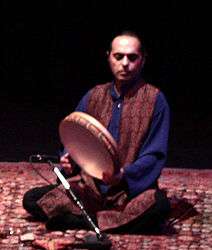 Iranian percussionist Majid Khalaj playing the dayereh | |
| Percussion instrument | |
|---|---|
| Other names | qaval |
| Classification | Frame drum |
| Hornbostel–Sachs classification | 211.311 (Directly struck membranophone) |
| Related instruments | |
History
The history of dayereh goes back to many centuries. An engraved bronze cup from Lorestān at the National Museum of Iran in Tehran, portrays a double ney (end-blown reed pipes), chang (harp), and dayereh in a shrine or court processional, as similarly documented in Egypt, Elam, and the Persian province of Babylonia where music was arranged for performance by large orchestral ensembles.[1]
In the Pahlavi (Persian pre-Islamic language) the name is dareh. The poet Abu Saeed Abolkheir (967–1048) mentioned in his works, the word dayereh as a drum.[1]
Regional variations
The dayereh is one of the most famous frame drums in Persia and Central Asia, and in the Pahlavi (Persian ancient language) the dayereh is called dareh.[1]
In Azerbaijan and Armenia, it is called ghaval[2] and sometimes daf/dap[3], and is played on festive occasions.[1] In Azerbaijani art music, the drum that usually accompanies the Ashigh (poet/singer) is ghaval (dayereh). A traditional ensemble contains a singer, who plays this drum, and two instrumentalists, one playing the tar (long-necked lute) and the other, the kamancheh (bowed spike fiddle).[1]
Structure and construction
The jingles which are thin metal plates or rings, are attached to hooks in three or four rectangular holes in the circular wooden frame. The drumhead is made of goat skin.
The width of the frame is 45–50 cm (18–20 in.) and the depth, 5–7 cm (2–3 in.). In order to bend the frame, the wood ("buka", "orev") may be softened in water before being bent around a hot metal cylinder.
The frame is closed by gluing the ends together. Finally, the skin is attached to the frame by fixing it with another wooden frame or by using nails.
Another variation is to have the ring-style jingles arranged around the edge of the inside of the drum the whole way around[4] or to have several tiers half way around the inside edge.[5]
Performance
The sound is produced by hitting the membrane with either hand – the left hand, which also holds the dayereh, strikes the edges, and the right hand strikes the center. The right-hand fingers are fastened about their neighbours and suddenly released (like the action of finger-snapping) to produce loud, rapid, sharp sounds.
The dayereh is a solo instrument. Most often it is supported by "Gajda", "chalgija", or "tarabuka". Marko Cepenkov mentions the dayereh as a companion of the "Gajda" in the 18th and 19th centuries.[6] It is most often used for keeping the rhythm in Macedonian folk songs and dances, and also in traditional Macedonian rituals, like wedding ceremony.[6]
References
- DVD of Tombak / Madjid Khaladj - Coproduction : Le Salon de Musique & École de Tombak | Langues : français, anglais, espagnol | Livret de 80 pages (français/anglais.)| EDV 937 CV.
- CD Infinit Breath / Madjid Khaladj, NAFAS / Bâ Music Records.
- in Ghaval by Dzhabbar Kariagdiev
- McCollum, Jonathan (2014). "Ghaval." New Grove Dictionary of Musical Instruments. Second Edition. Oxford University Press. ISBN 9780199743391.
- McCollum, Jonathan (2014). "Dap." New Grove Dictionary of Musical Instruments. Second Edition. Oxford University Press. ISBN 9780199743391.
- Ghaval image.
- "semi-ringed frame drum". Archived from the original on 2008-05-13. Retrieved 2008-05-23.
- Dayereh
External links
- Ghaval, the Azerbaijani frame drum
- Frame drums
- Frame Drums Central with image of semi-ringed frame drum
- Pakistan traditional instruments including "daira" and "daff"
.jpg)
